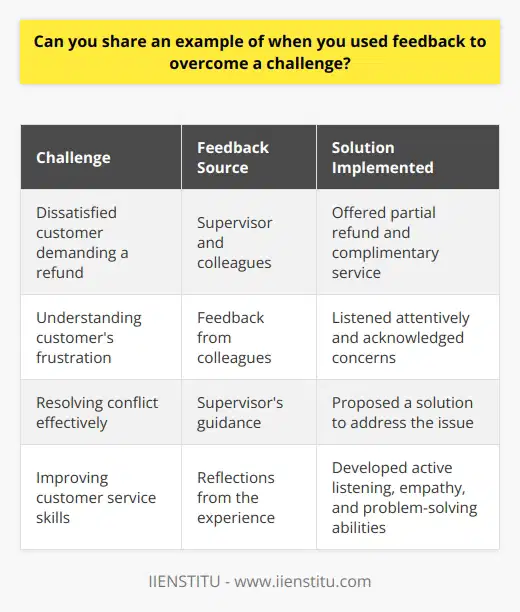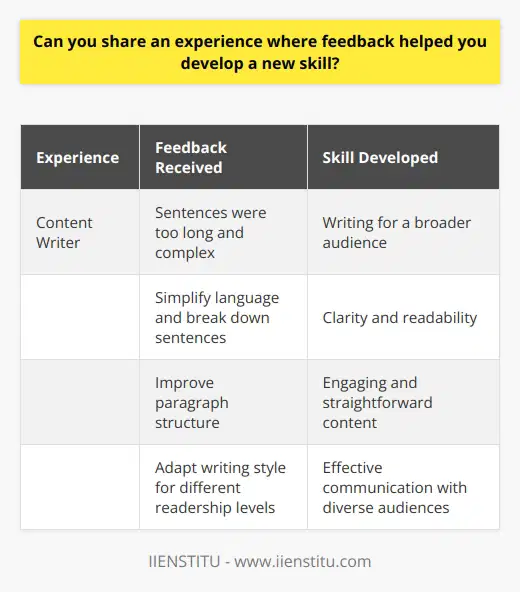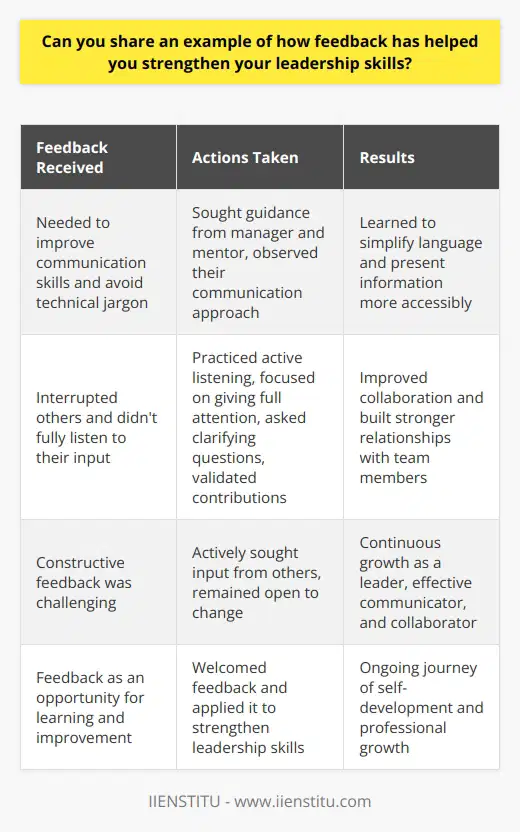
Feedback plays a crucial role in our personal and professional lives, shaping our growth and development. But have you ever wondered how feedback can impact your stress levels?
In this article, we will explore the intricate relationship between feedback and stress, its implications, and strategies to effectively manage stress in response to feedback. So, let's delve deeper into the question: "How does feedback affect your stress?"
Why is this interview question asked: How does feedback affect your stress?
Employers are increasingly recognizing the importance of creating a positive and supportive work environment. This interview question seeks to assess the candidate's understanding of the impact of feedback on stress levels and their ability to manage stress in a constructive manner.
Employers want to ensure that potential employees have the skills to handle feedback and stress effectively, fostering a healthy work culture.
The purpose of the question
The purpose of this question is to evaluate a candidate's self-awareness, emotional intelligence, and resilience. It helps to determine whether the candidate has a growth mindset and can effectively navigate feedback without succumbing to excessive stress.
Employers are keen to identify individuals who can use feedback as a tool for improvement rather than allowing it to negatively impact their well-being.
At what interview level is it asked?
This question is typically asked at mid-to-senior level positions where individuals are expected to handle feedback and stress with maturity and professionalism.
It is especially relevant for roles that involve client interactions, team management, or any position where feedback is a regular part of the job.
What kind of answer is expected from the candidate?
The ideal answer to this question demonstrates a candidate's ability to acknowledge the potential stress caused by feedback while highlighting effective strategies to mitigate its negative impact.
Employers seek individuals who can maintain a healthy balance between using feedback as a catalyst for growth and managing stress levels to ensure overall well-being.
Possible answers to consider
Emphasize the importance of self-awareness: The candidate can highlight the significance of recognizing their emotional reactions to feedback. By understanding their triggers and patterns, they can proactively manage stress and respond in a constructive manner.
Discuss open communication and clarification: Candidates can emphasize the value of open dialogue with the feedback provider. Seeking clarification and discussing the feedback in detail helps in gaining a better understanding, reducing ambiguity, and minimizing stress.
Acknowledge the power of perspective: Candidates can mention the importance of viewing feedback as an opportunity for growth, rather than as a reflection of their worth. Shifting the mindset towards a growth-oriented perspective can reduce stress and enhance resilience.
Highlight the need for self-care: Candidates can emphasize the significance of self-care techniques such as mindfulness, exercise, and pursuing hobbies. Taking care of one's physical and mental well-being can alleviate stress and enhance coping mechanisms.
Mention the role of constructive action: Candidates can discuss the importance of transforming feedback into actionable steps for improvement. By focusing on specific areas of development and setting achievable goals, individuals can channel their energy positively and reduce stress.
What to consider when answering
When answering this question, candidates should consider the following points:
Focus on positive aspects: Candidates should highlight their ability to learn from feedback and maintain a positive attitude. Emphasizing the potential growth opportunities presented by feedback showcases their adaptability and resilience.
Demonstrate emotional intelligence: Candidates should showcase their ability to manage their emotions effectively in response to feedback. This includes staying calm, seeking clarification, and responding constructively without allowing stress to overwhelm them.
Highlight past experiences: Candidates can draw on past experiences to illustrate how they have successfully managed feedback and stress in previous roles. Sharing specific examples demonstrates their ability to apply strategies and learn from challenging situations.
Discuss ongoing self-improvement: Candidates can mention their commitment to personal and professional development. Employers value individuals who actively seek feedback, engage in continuous learning, and adapt their behavior accordingly.
The impact of feedback on stress cannot be understated. It is essential for individuals to develop healthy coping mechanisms and cultivate a growth mindset to effectively manage stress levels.
By embracing feedback as an invaluable tool for personal and professional growth, individuals can transform stress into an opportunity for self-improvement. Remember, the way we respond to feedback shapes our journey towards success.
Types of Feedback and Associated Stress Levels
Relationship between Feedback Frequency and Stress
Influence of Feedback Accuracy on Stress Levels
Similar interview questions:
What is the impact of feedback on your stress levels?
In what ways does feedback influence your stress?
Could you explain how feedback affects your experience of stress?
Can you elaborate on how receiving feedback can impact your stress levels?
Do you believe that feedback has an effect on your stress? If so, how?
What role does feedback play in influencing your stress response?
How has feedback shaped your stress levels and reactions?
What correlations have you noticed between feedback and your stress levels?
What are your thoughts on the relationship between feedback and your stress levels?
Would you say that feedback has a significant impact on your stress?

Frequently Asked Questions
How do you handle criticism from your supervisor?
Accepting Criticism with Grace and Professionalism
Reflecting on Feedback
Discussing an Action Plan
Following Through
Maintaining a Positive Attitude
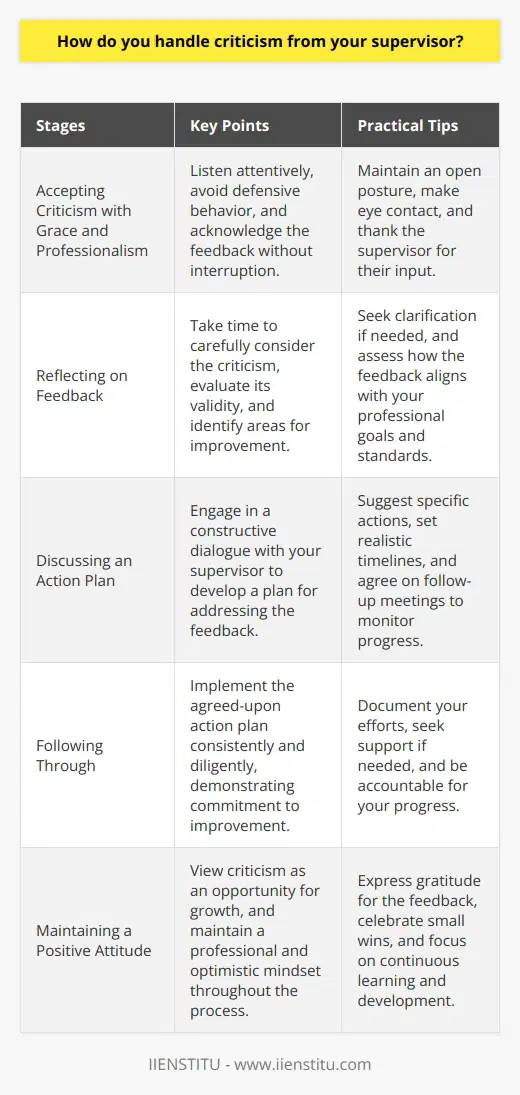
What strategies do you use to manage stress when receiving negative feedback?
When receiving negative feedback, I take a step back and assess the situation objectively. I recognize that constructive criticism is an opportunity for growth and improvement.
Strategies for Managing Stress
First, I practice deep breathing exercises to calm my mind and body. This helps me approach the feedback with a clear head. I also find it helpful to write down the key points of the feedback, so I can process it better.
Next, I ask clarifying questions to ensure I fully understand the feedback. This shows that I'm open to learning and value the other person's perspective. I try to avoid getting defensive or making excuses, and instead focus on how I can improve.
Maintaining a Positive Attitude
Throughout the process, I remind myself that everyone makes mistakes and that failures are stepping stones to success. I think about times in the past when I've received tough feedback and how it ultimately helped me grow. This helps me maintain a positive and resilient mindset.
After the conversation, I take time to reflect on the feedback and create an action plan. I break down my goals into smaller, manageable steps and celebrate my progress along the way. By staying focused on solutions rather than dwelling on the negative, I'm able to keep stress levels in check.
In the end, I view negative feedback as a gift. It's not always easy to hear, but it's an invaluable tool for personal and professional development. By using these strategies, I'm able to stay calm, centered, and motivated to keep improving.
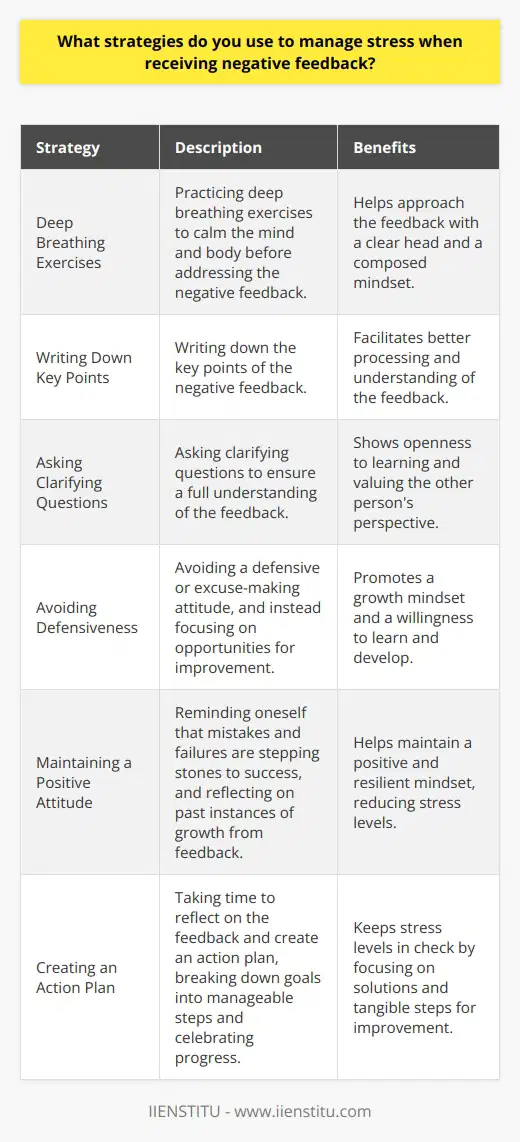
How do you maintain a positive attitude when faced with constructive feedback?
I believe that constructive feedback is an opportunity for growth and improvement. When faced with constructive criticism, I first take a step back and objectively assess the validity of the feedback. If the feedback is warranted, I acknowledge it and express gratitude to the person providing the input.
Developing an Action Plan
Next, I develop a plan of action to address the areas that need improvement. This may involve seeking guidance from colleagues, mentors, or supervisors on how to best implement changes. I set realistic goals for myself and track my progress over time.
Maintaining a Positive Mindset
Throughout the process, I maintain a positive attitude by viewing constructive feedback as a learning experience. I remind myself that everyone has room for growth and that feedback is not a personal attack, but rather a tool for professional development. By focusing on the potential for improvement, I stay motivated and engaged in my work.
Seeking Continuous Feedback
I also make it a point to proactively seek feedback from others on a regular basis. This helps me stay aware of my strengths and weaknesses and ensures that I am continuously working towards becoming a better professional. By maintaining an open and receptive attitude towards feedback, I demonstrate my commitment to personal and professional growth.
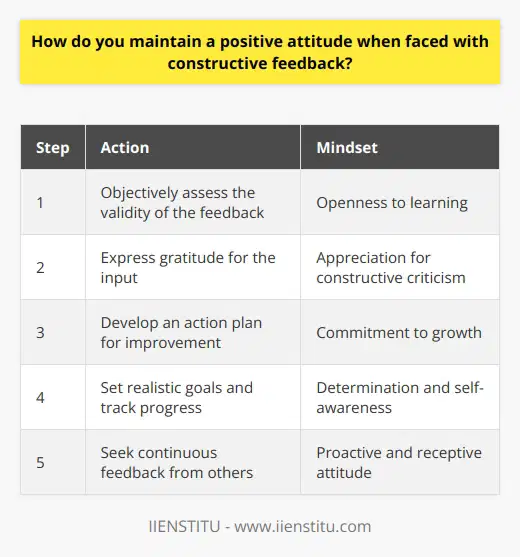
In what ways does positive feedback motivate you?
Positive feedback is a powerful motivator for me in several ways. First, it boosts my confidence and self-esteem. When my efforts are recognized and appreciated, I feel valued and encouraged to continue giving my best.
Reinforces My Strengths
Positive feedback helps me identify my strengths and the areas where I excel. It reinforces my belief in my abilities and motivates me to leverage those strengths to achieve even better results.
Real-Life Example
In my previous job, I received positive feedback from my manager for successfully leading a challenging project. She praised my organizational skills, attention to detail, and ability to motivate the team. This feedback made me feel proud and inspired me to take on more leadership roles in the future.
Encourages Continuous Improvement
While positive feedback acknowledges my accomplishments, it also motivates me to continuously improve and grow. It helps me set new goals and challenges, pushing me to step out of my comfort zone and develop new skills.
Personal Experience
I remember a time when a colleague complimented me on my presentation skills during a team meeting. She mentioned how engaging and informative my presentation was. This positive feedback encouraged me to refine my public speaking abilities further. I started attending workshops and practicing more, which ultimately enhanced my confidence and effectiveness in delivering presentations.
Creates a Positive Work Environment
Positive feedback contributes to a supportive and encouraging work environment. When I receive appreciation and recognition from my colleagues and superiors, it fosters a sense of camaraderie and teamwork. It motivates me to collaborate more effectively and support others in their endeavors.
Conclusion
In summary, positive feedback is a significant driver of my motivation. It boosts my confidence, reinforces my strengths, encourages continuous improvement, and creates a positive work environment. It fuels my desire to excel and makes me feel valued and appreciated in my professional life.
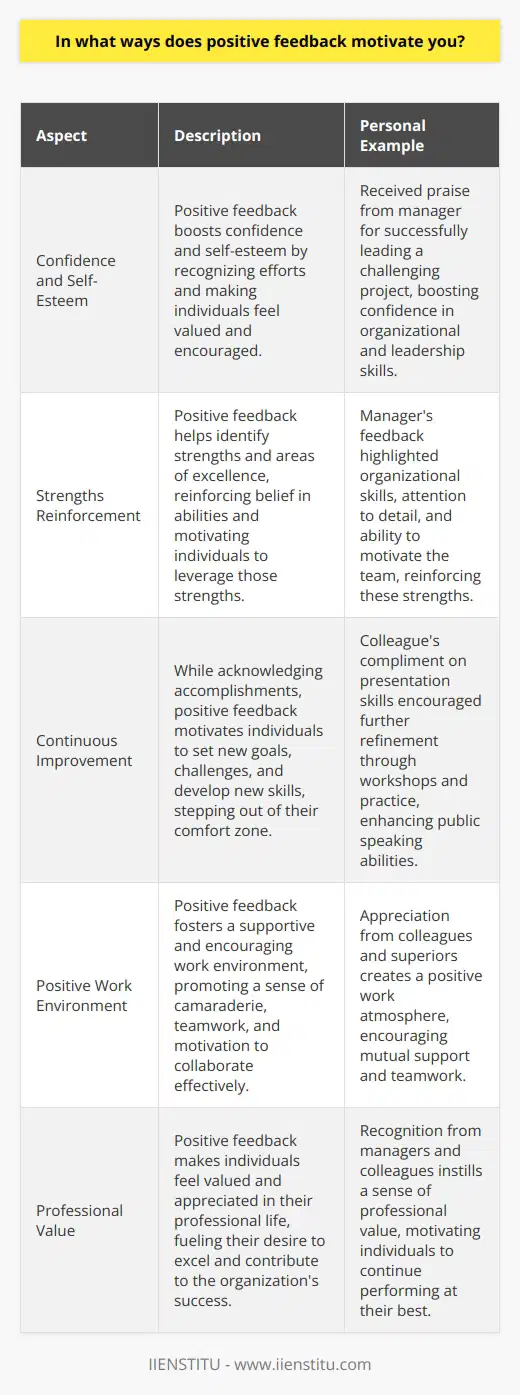
How do you distinguish between constructive and destructive feedback?
When distinguishing between constructive and destructive feedback, I consider the intention behind the comments. Constructive feedback aims to help me improve, while destructive feedback tends to be more critical without offering solutions.
Tone and Language
I pay attention to the tone and language used when receiving feedback. Constructive feedback is typically delivered in a supportive and encouraging manner, focusing on specific areas for improvement. On the other hand, destructive feedback often comes across as harsh, judgmental, or even personal attacks.
Actionable Steps
Constructive feedback provides concrete, actionable steps I can take to enhance my performance. It offers suggestions and strategies to overcome challenges and build upon my strengths. Destructive feedback, however, tends to point out flaws without offering any guidance on how to address them.
Timing and Setting
The timing and setting of the feedback also play a role. Constructive feedback is usually given in a private, one-on-one setting, allowing for open dialogue and clarification. Destructive feedback might be delivered in public or in a way that feels confrontational and uncomfortable.
Personal Growth
Ultimately, I believe constructive feedback is an opportunity for personal growth and development. It helps me identify areas where I can improve and provides the support and resources to do so. Destructive feedback, on the other hand, can be demotivating and hinder my progress.
By considering these factors, I strive to embrace constructive feedback while filtering out any destructive comments that don't contribute to my growth and success.
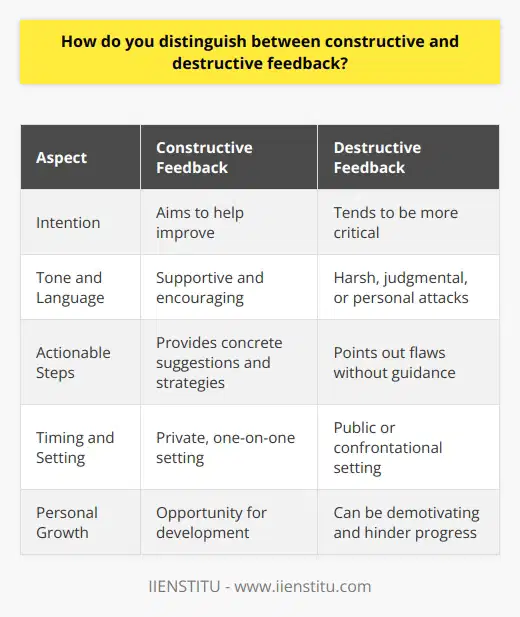
Can you describe a time when feedback helped you improve your performance?
<h3>Learning from Constructive Criticism</h3> <p>In my previous role as a project manager, I received some tough feedback from a client who felt I wasn't communicating proactively enough about project delays. While it stung to hear at first, I tried to accept the criticism gracefully. I took it as a challenge to improve my communication skills.
Implementing Changes Based on Feedback
I scheduled a meeting with the client to clarify their expectations and rebuilt trust through more frequent updates. Going forward, I made it a point to consistently share timelines, milestones, and any roadblocks with all stakeholders. As a result, my client relationships strengthened and I was able to manage projects more smoothly by proactively heading off issues.
A Lesson in Personal Growth
That experience taught me the importance of really listening to constructive criticism, no matter how much it might bruise the ego initially. Feedback, even when it's hard to hear, is a gift. It shows you where you have room to learn and grow. I'm grateful for that tough feedback early in my career, because it made me a better project manager and communicator in the long run.
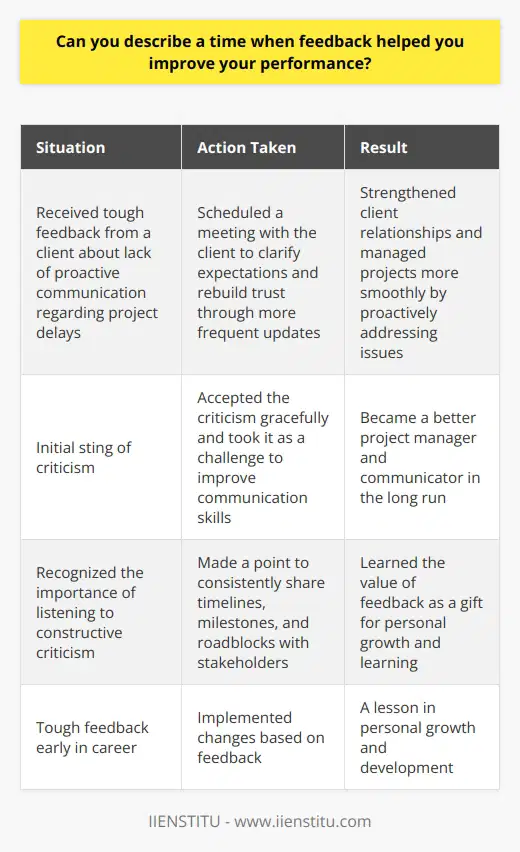
How do you prevent feedback from affecting your self-confidence?
I believe that receiving feedback, whether positive or negative, is an opportunity for growth and self-improvement. When faced with constructive criticism, I take a step back and objectively assess the validity of the comments. If the feedback is warranted, I use it as a learning experience to identify areas where I can enhance my skills or performance.
Maintaining a Positive Mindset
One key strategy I employ is to maintain a positive mindset. I remind myself that feedback is not a personal attack but rather a chance to gain valuable insights from others' perspectives. By viewing feedback as a tool for development, I prevent it from negatively impacting my self-confidence.
Seeking Clarification and Support
If I receive feedback that I find challenging or unclear, I proactively seek clarification. I engage in open and honest conversations with my colleagues or supervisors to better understand their perspective and gather specific examples or suggestions for improvement. Additionally, I surround myself with a supportive network of mentors and peers who provide encouragement and guidance.
Focusing on Strengths and Achievements
While it's important to address areas for improvement, I also make a conscious effort to recognize my strengths and achievements. I regularly reflect on my successes and the positive contributions I have made to my team and organization. By maintaining a balanced perspective and celebrating my accomplishments, I reinforce my self-confidence and resilience in the face of constructive feedback.
Ultimately, I view feedback as a valuable gift that helps me grow both professionally and personally. By approaching it with an open mind, a willingness to learn, and a focus on continuous improvement, I ensure that feedback serves as a catalyst for my development rather than a hindrance to my self-confidence.
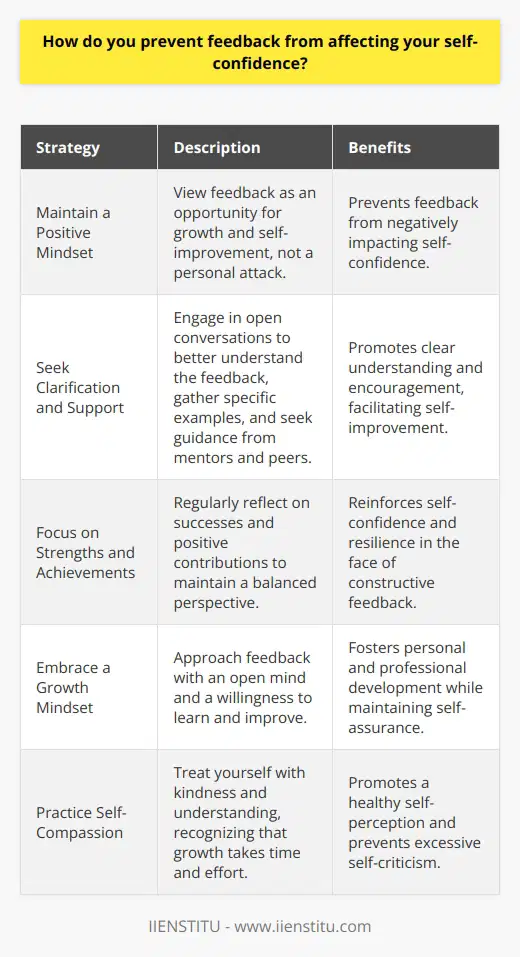
What role does feedback play in your personal growth and development?
Feedback plays a crucial role in my personal growth and development. It helps me identify areas where I excel and those that need improvement. By actively seeking feedback from colleagues, mentors, and managers, I gain valuable insights into my strengths and weaknesses.
Embracing Constructive Criticism
I view feedback, even when it's critical, as an opportunity to learn and grow. Instead of taking it personally, I analyze the feedback objectively and use it to make positive changes in my approach. Constructive criticism helps me refine my skills, improve my performance, and become a better professional.
Applying Feedback in Practice
When I receive feedback, I make a conscious effort to put it into practice. For example, if a manager suggests that I work on my presentation skills, I proactively seek opportunities to present in front of others and apply the techniques they recommended. By actively implementing feedback, I demonstrate my commitment to continuous improvement.
Seeking Feedback Proactively
I don't wait for others to provide feedback; I proactively seek it out. I regularly ask for input from my peers, supervisors, and even clients. This helps me stay aware of how others perceive my work and identify areas where I can enhance my performance.
Learning from Success and Failure
Feedback isn't just about identifying weaknesses; it's also about recognizing strengths. When I receive positive feedback, I reflect on what I did well and strive to replicate those successful strategies in the future. Similarly, when I encounter setbacks, I view them as learning experiences and use the feedback to bounce back stronger.
In summary, feedback is an essential tool for my personal growth and development. By embracing constructive criticism, applying feedback in practice, seeking it proactively, and learning from both success and failure, I continuously evolve and improve as a professional.
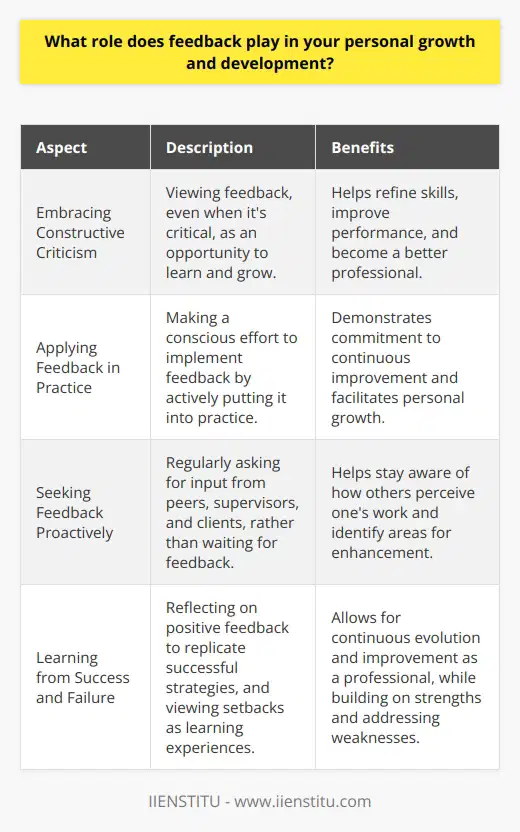
How do you ensure that you don't take feedback too personally?
<h3>Keeping an Open Mindset</h3> <h4>Viewing feedback as an opportunity for growth</h4>Whenever I receive feedback, whether positive or constructive, I strive to keep an open and receptive mindset. Rather than taking critiques personally or letting them deflate my confidence, I genuinely try to view all feedback as an opportunity for growth and improvement. Afterall, feedback from colleagues and managers, even when it stings a little, is almost always given with good intentions to help me develop and succeed in my role. <h4>Focusing on the content, not the delivery</h4>I find it helpful to focus on the core message and insights in the feedback while not getting hung up on the specific phrasing or delivery. We're all human and sometimes give feedback awkwardly or too bluntly, myself included. But by listening for the key takeaways and areas to work on, I'm able to get the maximum benefit from the feedback without taking any clumsy wording too much to heart. <h3>Actively Soliciting Feedback</h3> <h4>Normalizing regular feedback</h4>Something I try to do is proactively ask for feedback from my manager and peers on a regular basis. I've found that by normalizing feedback as a routine part of the job, both giving and receiving, it starts to feel a lot less personal and more like a standard part of professional development. The more feedback becomes a casual, everyday occurrence, the less fraught and personal it seems when areas for improvement inevitably come up.
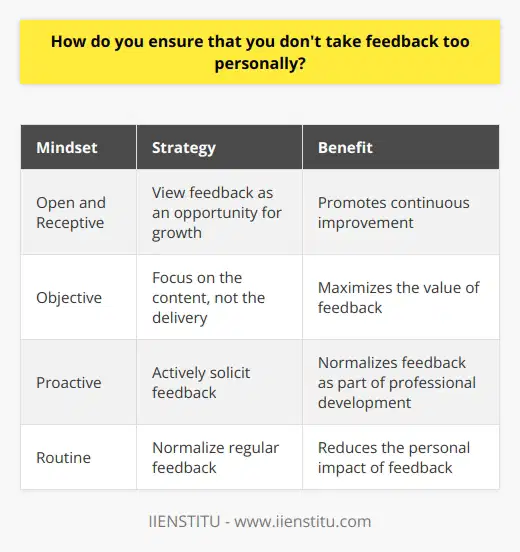
How do you manage your emotions when receiving unexpected feedback?
When receiving unexpected feedback, I try to remain calm and composed. I take a deep breath and listen attentively to understand the feedback fully. Even if the feedback is critical or not what I anticipated, I maintain a professional demeanor.
Seeking Clarification
If any part of the feedback is unclear, I ask questions to gain a better understanding. Seeking clarification helps me process the information accurately and respond appropriately. I might say something like, "Could you please elaborate on that point? I want to ensure I grasp it correctly."
Acknowledging and Reflecting
After receiving the feedback, I acknowledge it and express appreciation for the person's input. I might say, "Thank you for sharing your perspective. I value your insights." Then, I take a moment to reflect on the feedback objectively. I consider how it aligns with my own perceptions and identify areas for improvement.
Controlling Emotional Reactions
If the feedback triggers an emotional response, I consciously control my reactions. I remind myself that feedback is an opportunity for growth, not a personal attack. I focus on maintaining a neutral facial expression and body language. If needed, I might ask for a short break to collect my thoughts before responding.
Discussing Next Steps
Once I've processed the feedback, I engage in a constructive discussion about next steps. I ask for specific suggestions on how I can improve or address the concerns raised. I show a willingness to learn and adapt. I might say, "I appreciate your feedback. What steps would you recommend I take to improve in this area?"
By managing my emotions effectively during unexpected feedback, I demonstrate professionalism, adaptability, and a growth mindset. I view feedback as a valuable tool for personal and professional development, and I strive to handle it with grace and maturity.
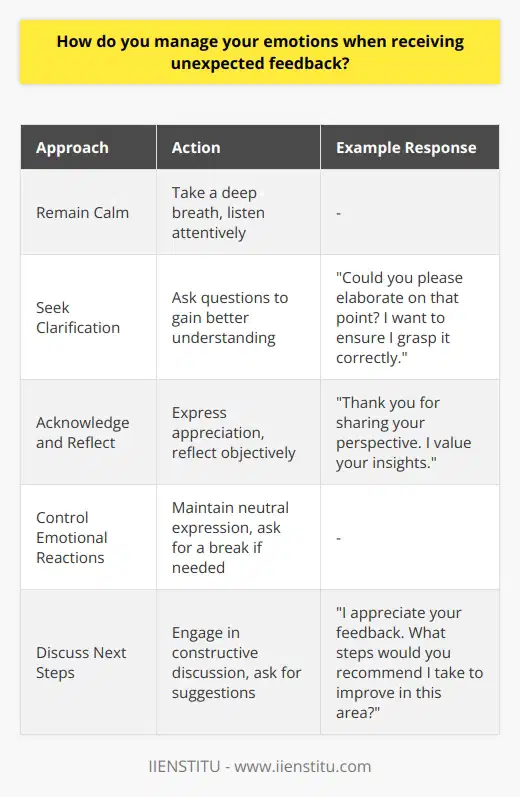
In what ways do you think feedback contributes to a healthy work environment?
Feedback is essential for creating a positive and productive work environment. When given constructively, it helps employees grow and improve their performance. Regular feedback sessions also foster open communication and trust between team members and management.
Benefits of Feedback
Feedback allows employees to understand their strengths and weaknesses. It provides them with actionable steps to enhance their skills and contribute more effectively to the organization's goals. Moreover, it shows that the company values their development and is invested in their success.
I once had a manager who scheduled monthly one-on-one meetings with each team member. During these sessions, we discussed our progress, challenges, and aspirations. Her personalized feedback and guidance helped me identify areas where I could improve and take on more responsibility. As a result, I felt more engaged and motivated in my role.
Creating a Feedback-Friendly Culture
To reap the benefits of feedback, it's crucial to create a culture that encourages open and honest communication. Leaders should model the behavior by actively seeking and providing feedback themselves. They should also train managers on how to deliver feedback effectively and create safe spaces for employees to share their thoughts and concerns.
In my experience, companies that prioritize feedback tend to have happier and more productive employees. When everyone feels heard and supported, they're more likely to collaborate, innovate, and go the extra mile.
Conclusion
Incorporating feedback into the workplace is a win-win for both employees and the organization. It leads to continuous learning, improved performance, and stronger relationships. By making feedback a regular part of the company culture, you can create a healthy and thriving work environment where everyone can reach their full potential.
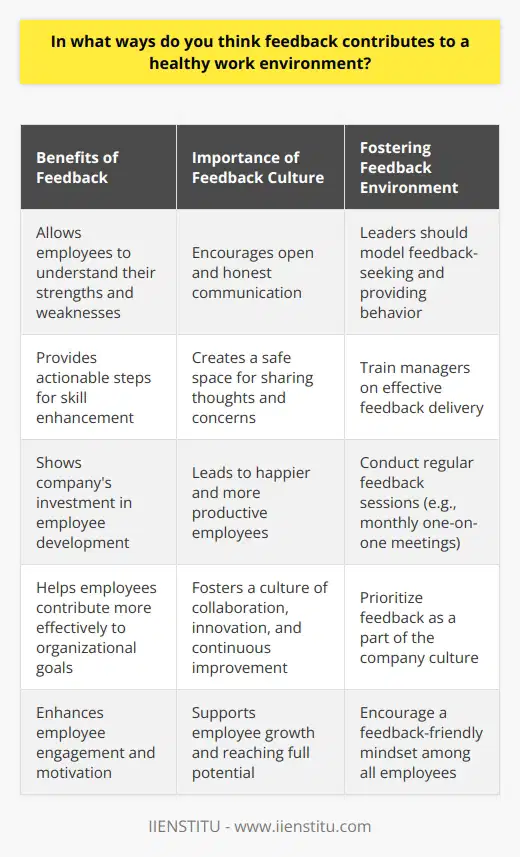
How do you balance the need for feedback with the potential stress it may cause?
Balancing the need for feedback with the potential stress it may cause is a delicate but important task. Throughout my career, I've learned that open communication is key to managing this balance effectively.
Establish Trust and Rapport
I believe that building strong relationships with colleagues is essential. When there's mutual trust and respect, people are more receptive to constructive feedback. I make an effort to connect with my team members on a personal level, showing genuine interest in their well-being and growth.
Deliver Feedback with Empathy
When providing feedback, I always consider the individual's perspective and feelings. I strive to be specific, focusing on behaviors rather than personal attributes. By using a supportive tone and acknowledging their efforts, I aim to minimize stress and encourage positive change.
Encourage Two-Way Dialogue
Feedback should be a conversation, not a monologue. I actively listen to my team's concerns and ideas. By creating a safe space for open dialogue, we can collaboratively identify areas for improvement and develop actionable plans. This approach fosters a sense of ownership and reduces anxiety.
Celebrate Successes
Recognizing achievements is just as important as addressing challenges. I make a point to celebrate my team's successes, both big and small. Positive reinforcement boosts morale and confidence, making it easier to handle constructive feedback when necessary.
Ultimately, balancing feedback and stress requires empathy, trust, and open communication. By approaching feedback as a growth opportunity, we can create a supportive environment that drives personal and professional development.
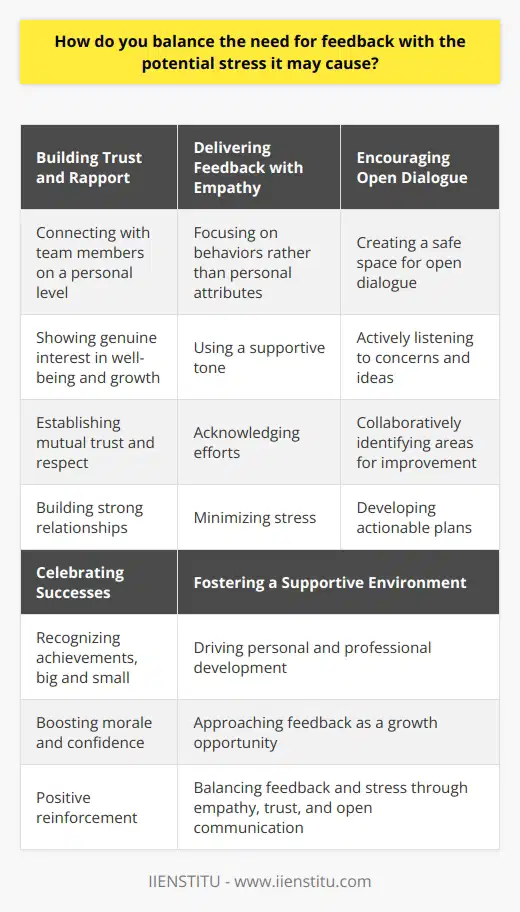
Can you describe a situation where feedback helped you identify a blind spot in your work?
In my previous role as a marketing coordinator, I was tasked with creating a social media campaign. I worked diligently on the project, but when I presented it to my supervisor, she provided constructive feedback that made me realize I had overlooked a crucial aspect of our target audience.
Identifying the Blind Spot
Her feedback helped me see that I had focused too heavily on one demographic while neglecting another equally important segment. This blind spot in my approach could have led to a less effective campaign.
Taking Action
Armed with this new perspective, I went back to the drawing board. I conducted additional research and revised my strategy to ensure it resonated with our entire target audience. The final campaign was much stronger as a result.
Lessons Learned
This experience taught me the value of seeking and embracing feedback. It's easy to get tunnel vision when you're deep into a project, but fresh eyes can help identify areas for improvement that you might have missed. Since then, I've made a habit of proactively seeking input from colleagues and supervisors to ensure I'm considering all angles.
I'm grateful for that supervisor's feedback because it not only improved that specific project but also helped me grow as a professional. It taught me the importance of being open to constructive criticism and using it to refine my work.
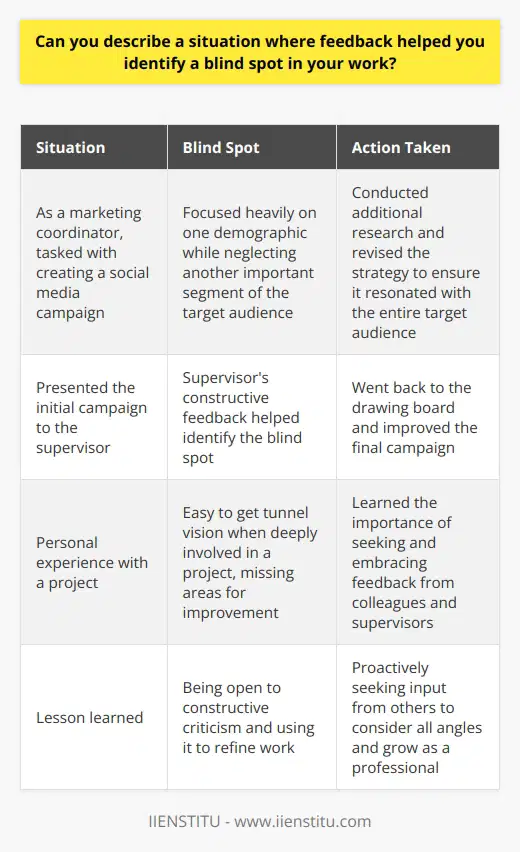
How do you determine which feedback is most valuable for your growth?
I believe the most valuable feedback for growth comes from those who have a vested interest in my success. This could be a manager, mentor, or colleague who understands my role and goals. I also find feedback that is specific and actionable to be the most helpful.
Seeking Out Diverse Perspectives
While feedback from those close to my work is invaluable, I also try to seek out diverse perspectives. Getting input from people in different roles or departments can highlight blind spots and offer fresh insights. I'm always eager to learn how my work impacts others.
Evaluating Feedback Objectively
When receiving feedback, I try to evaluate it objectively. I consider the person's expertise, motives, and the relevance to my development goals. If something doesn't resonate right away, I'll reflect on it before dismissing it. Often, challenging feedback can spark the most growth.
Looking for Patterns
I also look for patterns in the feedback I receive. If I'm hearing similar things from multiple people, that's usually a sign that it's something I need to work on. Consistently positive feedback helps me identify my strengths.
Putting Feedback Into Action
Ultimately, the most valuable feedback is that which I can put into action. I try to come away from feedback conversations with clear next steps. Whether it's working on a specific skill or changing my approach, I'm always looking for ways to translate feedback into growth.
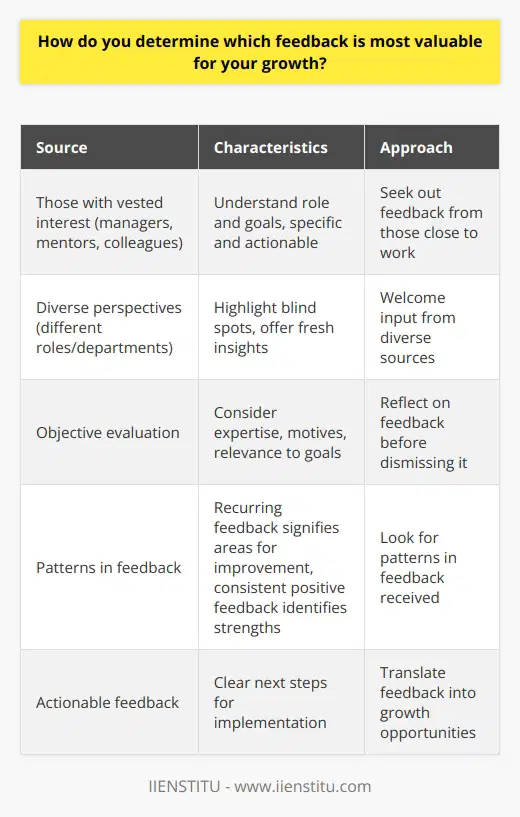
What techniques do you use to process and internalize feedback effectively?
When it comes to processing and internalizing feedback effectively, I rely on a few key techniques. First, I actively listen to the feedback without interrupting or getting defensive. This allows me to fully understand the perspective of the person providing the input.
Taking Notes and Asking Questions
During the feedback session, I take notes to ensure I capture all the important points. If something is unclear, I ask clarifying questions to gain a better understanding. This helps me avoid misinterpretations and ensures I have a complete picture of the feedback.
Reflecting on the Feedback
After receiving feedback, I take some time to reflect on it. I consider how the feedback aligns with my own self-assessment and identify areas where I agree or disagree. This introspection allows me to gain deeper insights and determine the most valuable takeaways from the feedback.
Creating an Action Plan
Once I've processed the feedback, I create an action plan to address the areas that need improvement. I break down the feedback into specific, measurable goals and outline the steps I'll take to achieve them. This action plan serves as a roadmap for my personal and professional growth.
Seeking Support and Follow-Up
I also seek support from mentors, colleagues, or supervisors who can provide guidance and accountability as I work on implementing the feedback. I schedule follow-up meetings to discuss my progress, celebrate successes, and make any necessary adjustments to my action plan.
By using these techniques, I'm able to effectively process and internalize feedback, turning it into actionable steps for continuous improvement and growth in my career.
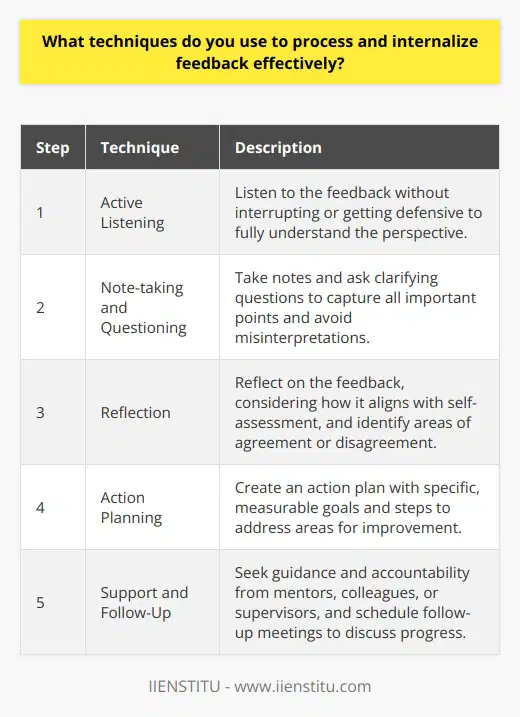
How do you maintain open communication with your team when exchanging feedback?
Encourage Honest Feedback
I believe the key to open communication when exchanging feedback is creating an environment where people feel safe being honest. In my experience leading projects at my last company, I made a point to regularly check in with each team member one-on-one. During these informal chats, I'd ask how they felt the project was going and if they had any concerns or suggestions. I found that by having these conversations frequently in a casual setting, it made people much more comfortable bringing up issues early on before they festered and became bigger problems. The discussions weren't always easy, but I believe that candid, constructive feedback delivered with empathy and respect is critical for teams to learn and improve.
Lead by Example
As a leader, it's important that I model the open communication I expect from my team. So when someone shares feedback with me, whether positive or negative, I make sure to listen carefully, ask questions to fully understand their perspective, and thank them for having the courage to be honest. I'm not perfect, so I own up to my mistakes and shortcomings. I think showing that vulnerability and willingness to acknowledge flaws and grow from them sets the tone that it's okay, and in fact encouraged, to have those difficult conversations. My goal is always for feedback to flow in all directions - not just top-down but also bottom-up and peer-to-peer, to create a true culture of openness and continuous improvement.
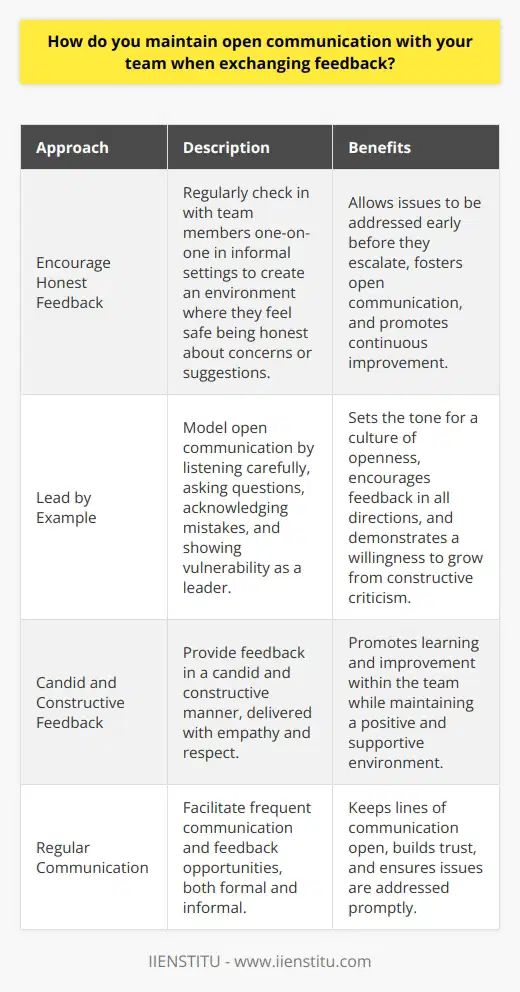
How do you prioritize feedback when you receive conflicting opinions?
When faced with conflicting opinions, I first seek to understand the reasoning behind each perspective. I listen actively and ask clarifying questions to gain a deeper understanding of the feedback.
Identify Common Themes
Next, I look for common themes or areas of agreement among the different viewpoints. Even if opinions seem contradictory on the surface, there may be underlying points of consensus that can guide my approach.
Assess Relevance and Impact
I evaluate each piece of feedback based on its relevance to the project goals and its potential impact. I prioritize suggestions that align with key objectives and have the greatest potential to improve outcomes.
Trust My Judgment
Ultimately, I trust my own judgment to weigh the merits of each opinion and make a decision. As the person responsible for the work, I must be confident in my choices while still considering others' input.
Communicate My Rationale
Once I've decided on a course of action, I communicate my rationale to stakeholders. I explain how I arrived at my decision and how it addresses the most critical aspects of the feedback received.
By following this approach, I can navigate conflicting opinions thoughtfully and arrive at solutions that drive the best results.
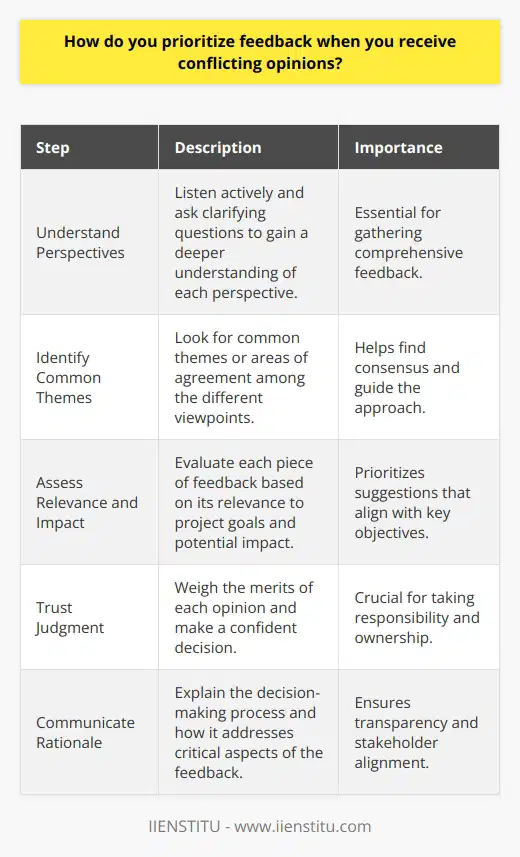
What role does self-reflection play in your ability to handle feedback?
Self-reflection is a crucial skill that helps me handle feedback effectively. I always take time to analyze my actions and decisions objectively. This allows me to understand my strengths, weaknesses, and areas for improvement.
Embracing Constructive Criticism
When I receive feedback, whether positive or negative, I embrace it as an opportunity for growth. I listen actively and ask clarifying questions to fully grasp the perspective of the person providing the feedback. I avoid getting defensive and instead focus on understanding how I can improve.
Learning from Mistakes
I believe that mistakes are valuable learning experiences. When I make an error, I reflect on what went wrong and how I can prevent similar missteps in the future. I take responsibility for my actions and seek guidance when needed.
Example: Missed Deadline
Once, I missed an important project deadline due to poor time management. After receiving feedback from my supervisor, I took a step back and critically examined my work processes. I realized that I needed to improve my prioritization skills and break down tasks into smaller, manageable chunks. Since then, I've become more organized and have consistently met deadlines.
Continuous Self-Improvement
Self-reflection is an ongoing process for me. I regularly assess my performance, seeking ways to enhance my skills and knowledge. I'm always open to feedback and actively seek it from colleagues and mentors. By continuously improving myself, I can contribute more effectively to my team and the organization.
In summary, self-reflection is essential to my ability to handle feedback. It allows me to gain insights, learn from mistakes, and continuously grow both personally and professionally. I believe that by embracing feedback and engaging in regular self-reflection, I can achieve my full potential and be a valuable asset to any team.
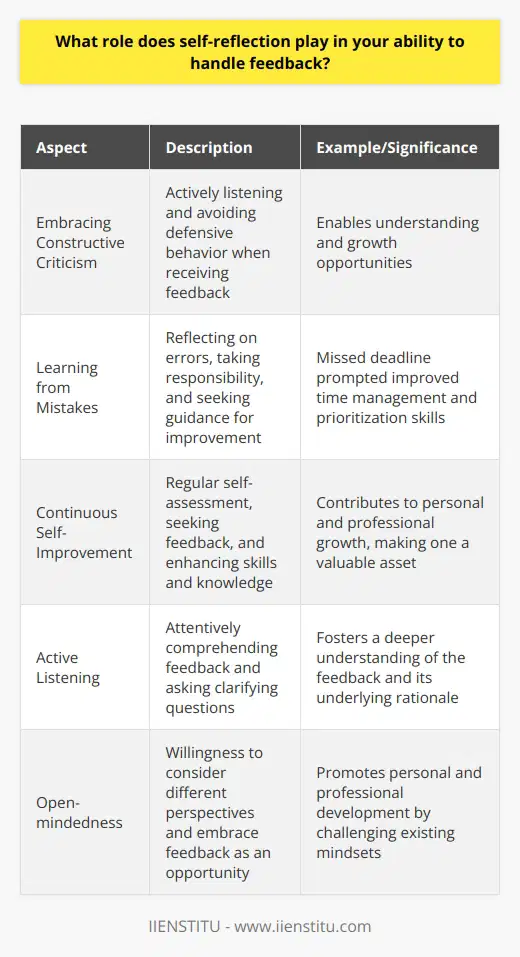
How do you create a feedback-friendly environment within your team?
I believe creating a feedback-friendly environment starts with building trust and rapport within the team. I make sure to actively listen to each team member and show genuine interest in their ideas and concerns. This helps foster open communication and makes them feel valued and respected.
Leading by Example
I strive to model the behavior I want to see in my team. When someone provides feedback, I thank them sincerely and take action on their suggestions. This demonstrates that I'm open to constructive criticism and committed to continuous improvement.
Encouraging Regular Check-Ins
I schedule regular one-on-one meetings with each team member to discuss their progress, challenges, and goals. These informal chats create a safe space for them to share feedback and ideas without fear of judgment. I also use this time to provide specific, actionable feedback to help them grow and develop.
Celebrating Wins and Learning from Mistakes
When a team member does something well, I make sure to recognize and celebrate their success publicly. This boosts morale and encourages others to strive for excellence. At the same time, I view mistakes as learning opportunities rather than reasons for punishment. We openly discuss what went wrong and brainstorm ways to improve next time.
By consistently practicing these strategies, I've been able to cultivate a feedback-rich culture where everyone feels heard, supported, and empowered to do their best work. It's an ongoing process, but the results - higher engagement, productivity, and innovation - are well worth the effort.
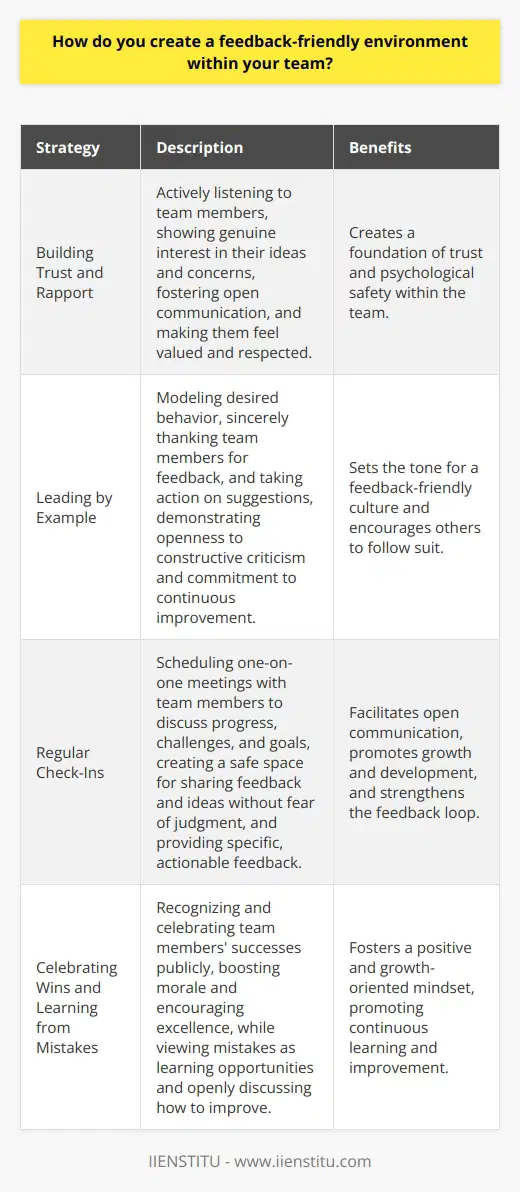
Can you describe a time when you had to give difficult feedback to a colleague?
I once had to give difficult feedback to a colleague who consistently missed deadlines and produced subpar work. It was a challenging situation because I didn't want to damage our working relationship, but I knew that the issues needed to be addressed for the sake of the project and the team.
Preparing for the Conversation
Before approaching my colleague, I took some time to gather specific examples of the problems I had noticed. I wanted to ensure that my feedback was objective and constructive, rather than personal or emotionally charged. I also considered the best time and place to have the conversation, choosing a private setting where we could talk without interruptions.
Delivering the Feedback
When I met with my colleague, I started by acknowledging their strengths and contributions to the team. I then calmly and clearly explained the concerns I had about their missed deadlines and the quality of their work, providing specific examples to illustrate my points. I focused on the impact of their actions on the project and the team, rather than making personal attacks.
Finding Solutions Together
After delivering the feedback, I opened the conversation for my colleague to share their perspective and any challenges they were facing. We worked together to identify the root causes of the issues and brainstorm potential solutions. I offered my support and resources to help them improve their performance and meet the project requirements.
Following Up
In the weeks following our conversation, I made a point to check in with my colleague regularly and provide ongoing feedback and support. I noticed a significant improvement in their work and a stronger commitment to meeting deadlines. By addressing the issues constructively and collaboratively, we were able to strengthen our working relationship and contribute to the success of the project.
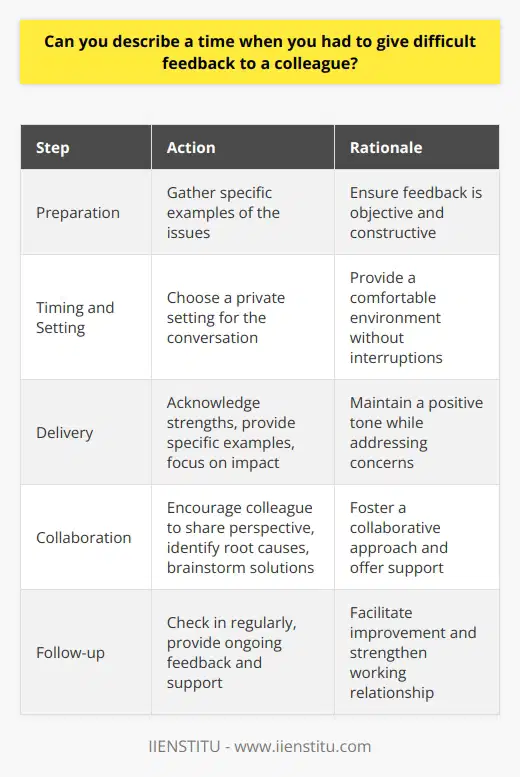
How do you ensure that feedback leads to actionable improvements in your work?
I believe that feedback is crucial for personal and professional growth. Whenever I receive feedback, whether it's positive or negative, I take the time to reflect on it and identify areas where I can improve.
Analyzing Feedback
I start by analyzing the feedback objectively. I ask myself questions like, "What specific points were raised?" and "How can I address these concerns?" This helps me break down the feedback into actionable steps.
Creating an Action Plan
Once I have a clear understanding of the feedback, I create an action plan. I set realistic goals for myself and outline the steps I need to take to achieve them. I also set deadlines to hold myself accountable.
Seeking Clarification and Guidance
If there are any aspects of the feedback that I'm unsure about, I don't hesitate to seek clarification. I reach out to my colleagues or supervisors for guidance and advice. Their insights often provide me with new perspectives and ideas.
Implementing Changes and Monitoring Progress
With my action plan in place, I start implementing the necessary changes. I focus on one improvement at a time to avoid feeling overwhelmed. I regularly monitor my progress and make adjustments as needed. Celebrating small victories along the way keeps me motivated.
Continuous Learning and Growth
I view feedback as an opportunity for continuous learning and growth. I embrace challenges and use them as stepping stones to become a better professional. By consistently applying feedback and striving for improvement, I aim to exceed expectations and contribute to my team's success.
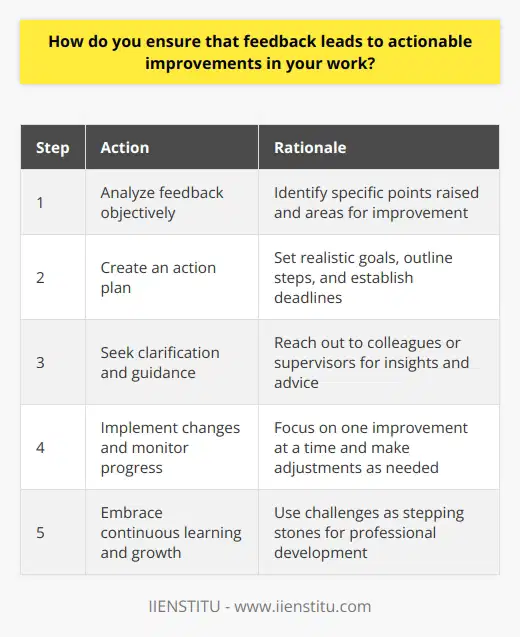
What strategies do you use to seek out feedback proactively?
I believe in the power of proactive feedback-seeking to drive personal and professional growth. To actively seek out feedback, I employ several strategies:
Establishing Open Communication Channels
I strive to foster open and honest communication with my colleagues, supervisors, and clients. By creating an environment where feedback is welcomed and encouraged, I find that people are more willing to share their insights and observations.
Requesting Specific Feedback
Instead of simply asking for general feedback, I try to be specific in my requests. I might ask about a particular project, skill, or behavior that I want to improve upon. This helps me gather targeted and actionable feedback.
Embracing a Growth Mindset
I approach feedback with a growth mindset, viewing it as an opportunity to learn and develop. Even when the feedback is critical or challenging, I try to focus on the lessons I can take away from it.
Implementing Feedback and Following Up
When I receive feedback, I make a conscious effort to implement it in my work. I also follow up with the person who provided the feedback to discuss my progress and gather further insights.
By proactively seeking out feedback and using it to guide my personal and professional development, I believe I can continuously improve and grow in my role.
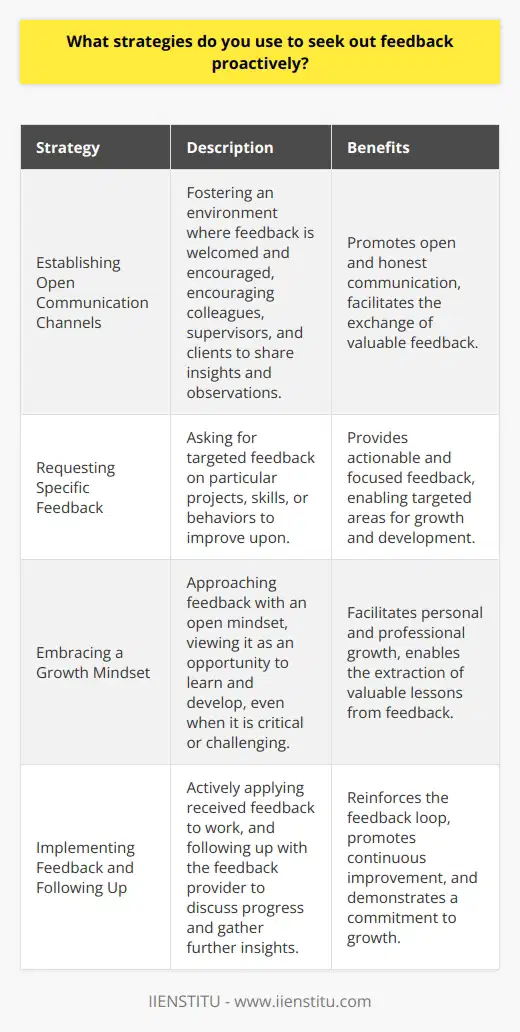
How do you balance the need for immediate action with the time required to process feedback?
In my experience, balancing immediate action with processing feedback is a delicate dance that requires quick thinking and adaptability. I've found that the key is to prioritize the most pressing issues while still leaving room for reflection and course correction.
Triage and Prioritize
When faced with a situation that demands swift action, I quickly assess the urgency and impact of each task. I tackle the most critical items first, ensuring that any potential crises are averted and that the team can continue moving forward.
Iterate and Adjust
As I'm working on immediate actions, I keep an open mind and ear to incoming feedback. If new information arises that challenges my initial approach, I'm not afraid to pivot and adjust my strategy on the fly.
Reflect and Learn
Once the dust has settled, I take a step back to process the feedback more thoroughly. I analyze what worked well, what could be improved, and how we can apply those lessons learned to future situations.
Communicate and Collaborate
Throughout the entire process, I maintain open lines of communication with my team. I share my thought process, solicit their input, and ensure that everyone is aligned and working towards the same goals.
Balancing immediate action with processing feedback is a challenging but essential skill in today's fast-paced work environment. By staying agile, reflective, and collaborative, I've been able to navigate even the most demanding situations with success.

How do you use feedback to set meaningful goals for yourself and your team?
I believe that feedback is essential for setting meaningful goals and driving continuous improvement. When I receive feedback from my manager or colleagues, I take the time to reflect on it and identify areas where I can grow and develop.
Using Feedback to Set Personal Goals
For example, if I receive feedback that I need to improve my presentation skills, I'll set a goal to practice delivering presentations and seek opportunities to present to my team or stakeholders. I'll also ask for specific feedback on my presentations to track my progress.
Translating Feedback into Team Goals
When it comes to my team, I use feedback to identify areas where we can improve collectively. If we receive feedback that we need to improve our collaboration with other departments, I'll work with my team to set goals around building stronger relationships and improving communication.
Encouraging a Culture of Feedback
I also believe in creating a culture of feedback within my team. I encourage my team members to seek feedback from each other and from stakeholders, and I make sure to provide regular feedback to my team as well. By creating an environment where feedback is valued and acted upon, we can continuously improve and grow together.
Measuring Progress and Adjusting Goals
Finally, I believe in regularly measuring progress against our goals and adjusting as needed. If we're not making the progress we'd like, we'll reassess our goals and strategies and make changes to get back on track. By staying flexible and adaptable, we can ensure that we're always working towards meaningful goals that drive business success.
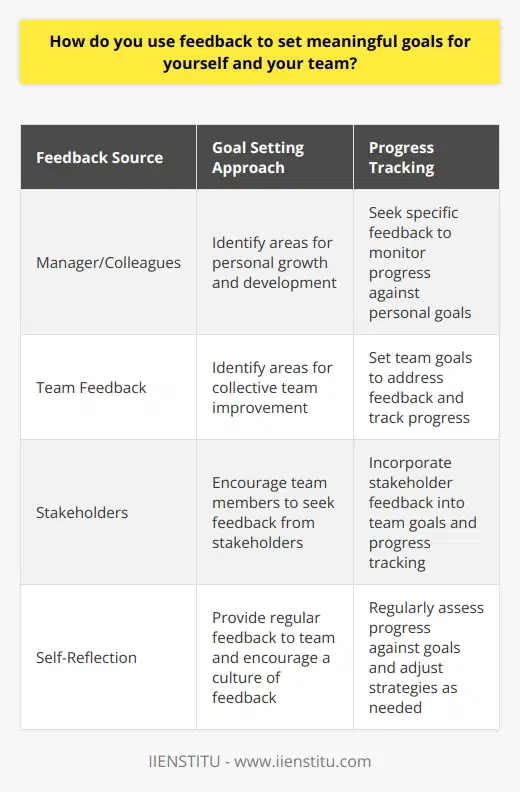
In what ways do you think a company's feedback culture impacts employee stress levels?
A company's feedback culture can greatly impact employee stress levels. When feedback is given constructively and regularly, it helps employees feel valued and supported. This open communication allows them to understand their strengths and areas for improvement, reducing uncertainty and anxiety.
Positive Feedback Boosts Morale
Recognizing employees' hard work and achievements through positive feedback goes a long way in boosting morale. It shows that their efforts are appreciated, motivating them to continue performing well. Knowing that their contributions matter reduces stress and increases job satisfaction.
Negative Feedback Can Increase Stress
On the flip side, negative feedback, especially when delivered harshly or without constructive suggestions, can heighten employee stress. It may leave them feeling criticized, undermined, and unsure of their abilities. This can lead to self-doubt, decreased confidence, and a stressful work environment.
Inconsistent or Lack of Feedback Creates Uncertainty
When feedback is inconsistent or lacking altogether, employees are left in the dark about their performance. This uncertainty can breed stress and anxiety, as they are unsure if they are meeting expectations or heading in the right direction. Regular feedback, even if it's brief, helps alleviate this stress.
Feedback Culture Impacts Overall Work Environment
A company's feedback culture sets the tone for the overall work environment. If it's one of open communication, support, and growth, employees are more likely to feel comfortable and less stressed. They know that their concerns will be heard and addressed, creating a positive atmosphere.
In my experience, working in a company with a strong feedback culture has greatly reduced my stress levels. Knowing that my manager is invested in my growth and provides regular, constructive feedback has given me clarity and confidence in my role. It has made a significant difference in my job satisfaction and overall well-being.
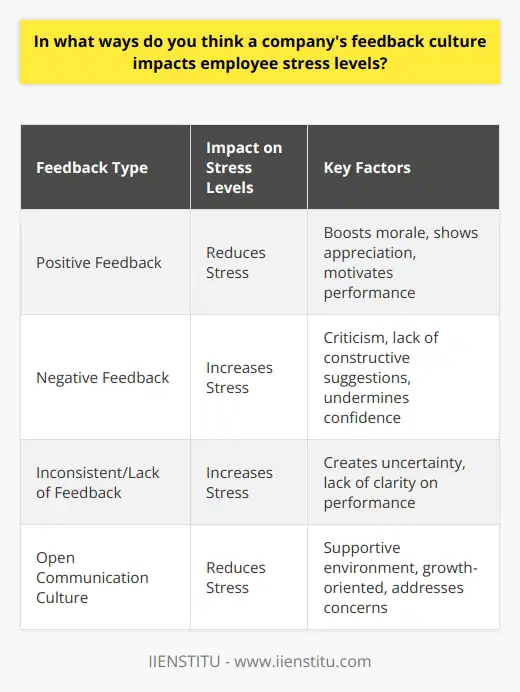
How do you foster a growth mindset when receiving challenging feedback?
Receiving challenging feedback is an opportunity for growth and improvement. I actively seek out constructive criticism from colleagues and supervisors. By maintaining an open mind, I can gain valuable insights into areas where I can develop professionally.
Embracing a Positive Attitude
When faced with tough feedback, I focus on the potential for personal development. I view critiques as a chance to learn and expand my skill set. Approaching feedback sessions with a positive outlook helps me stay receptive to new ideas and perspectives.
Asking Clarifying Questions
To fully understand the feedback I receive, I ask questions to gain clarity. I want to ensure I grasp the specific areas that need improvement. Engaging in a dialogue also demonstrates my commitment to growth and willingness to collaborate.
Developing an Action Plan
After receiving challenging feedback, I take time to reflect on the insights shared. I identify concrete steps I can take to address the areas mentioned. Creating a plan of action helps me stay focused and accountable as I work towards improvement.
Seeking Support and Resources
I'm not afraid to ask for help when implementing changes based on feedback. I reach out to mentors, colleagues, or supervisors for guidance and support. Leveraging available resources, such as training programs or workshops, can also aid in my growth journey.
Celebrating Progress and Milestones
As I work on the areas highlighted in the feedback, I acknowledge my progress along the way. Celebrating small wins keeps me motivated and reinforces the value of a growth mindset. I also express gratitude to those who provided the feedback, recognizing their investment in my development.
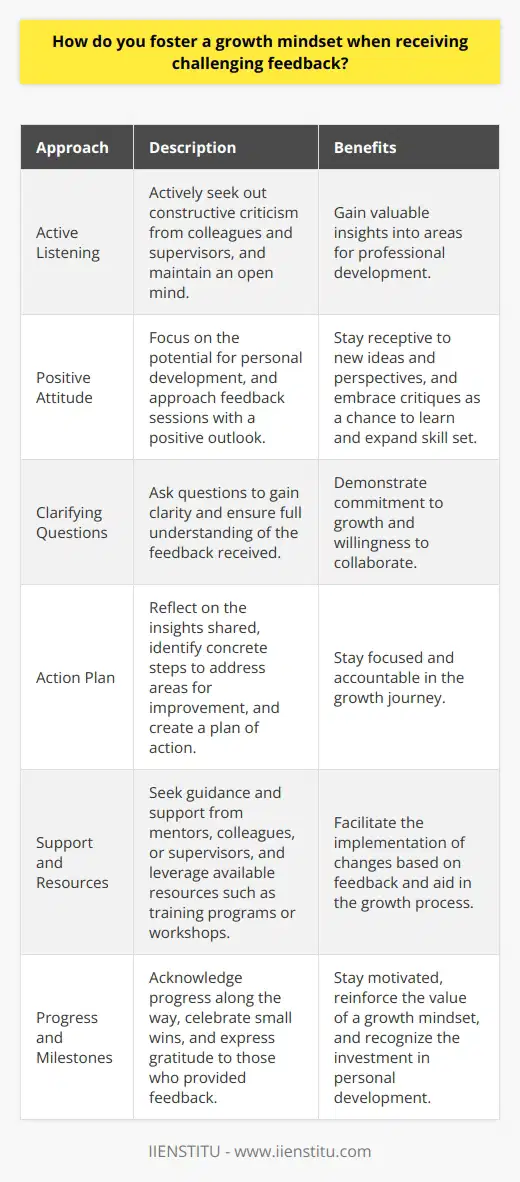
What role does empathy play in your ability to receive and provide feedback effectively?
Empathy is a crucial skill in both receiving and providing feedback effectively. When I receive feedback, I put myself in the other person's shoes and try to understand their perspective. This helps me appreciate their insights and avoid getting defensive.
Giving Constructive Feedback
When giving feedback, I consider how my words might impact the other person emotionally. I aim to be honest yet compassionate. For example, rather than bluntly criticizing, I share specific observations and offer suggestions for improvement.
Adapting Communication Style
I pay attention to body language and adjust my approach based on the individual. Some respond best to direct feedback, while others need a gentler touch. Being attuned to these nuances through empathy makes the exchange more productive.
Seeking to Understand
Asking questions is key. I dig deeper to grasp the root of the feedback - what prompted it and what goals we're working towards together. Empathy helps me see feedback as a collaboration, not a personal attack.
Learning and Growing
Ultimately, empathy allows me to embrace feedback as an opportunity for growth. When I step into the other person's viewpoint, I can more readily absorb their wisdom. I recall a time when a supervisor gave me tough feedback. It stung at first, but by considering her intent to help me improve, I was able to channel it into meaningful development.
In summary, empathy is the foundation of effective feedback exchanges. It guides my words, opens my mind, and transforms critiques into catalysts for positive change.

